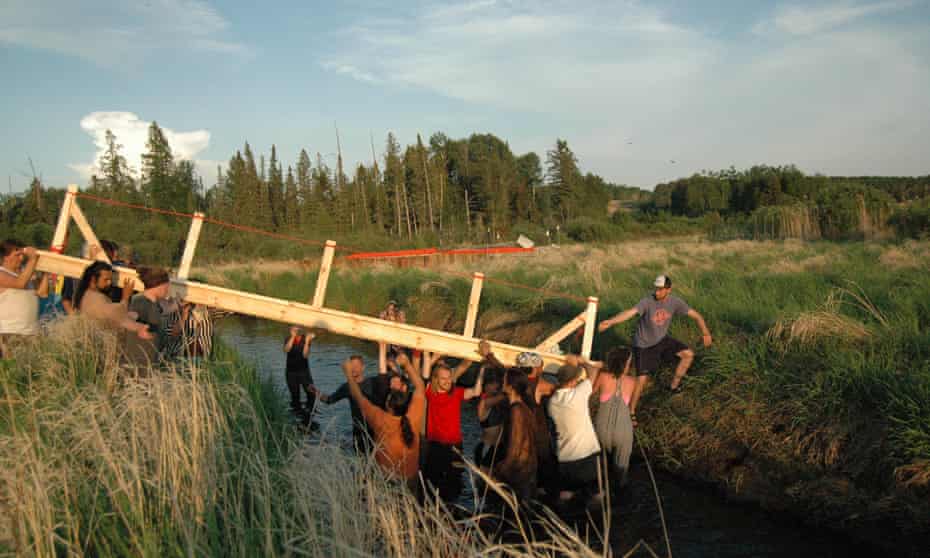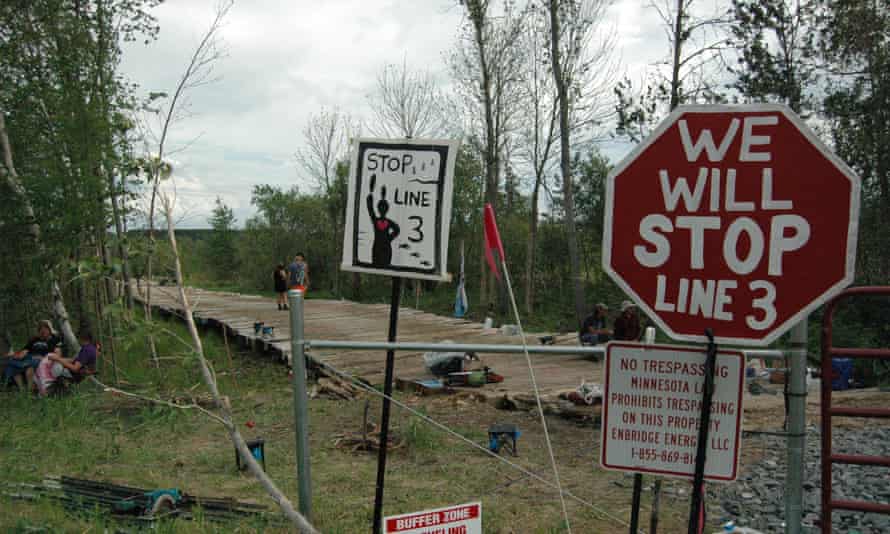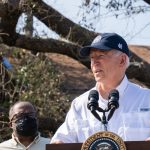As the sun set, more than a dozen young people carried a wooden bridge toward a narrow section of the Mississippi River. The bridge allowed the group to cross more easily from their camp to where the immense oil pipeline was being built on the other side.
They were cited for trespassing – but they had symbolically laid claim to the marshy landscape.
That same day, Dawn Goodwin’s voice was soft but forceful as she spoke into the camera: “I’m calling on you, Joe Biden, to uphold our treaties, because they are the supreme law of the land.”
Goodwin, an Ojibwe woman and environmental activist, was recording a livestream from a picturesque camp site amid northern Minnesota’s natural beauty – where she and dozens of others had come together to protest the construction of the Line 3 pipeline.
Across the state, along the pipeline’s planned route of construction, activists have traveled from all over the country to do the same: many have locked themselves to construction equipment, and hundreds have been arrested. Goodwin’s preferred method of protest is arguably less physical – she was in the middle of leading a four-day prayer ceremony – but she hoped it would be no less effective to draw attention to the potential harm the pipeline represents.
“We’re done messing around with the process and trusting that the process is going to work, because in the end, it failed us,” she said. “What am I trusting instead? The power of the people, and the creator.”
The proposed Line 3 pipeline – which, if expanded, would move crude oil from Alberta in Canada through Minnesota to Wisconsin – has quickly become the biggest target of US environmental advocates. In addition to attracting protesters from around the country, it’s bringing attention to Biden’s unfulfilled promises so far on the climate crisis, as advocates argue he could step in to stop an expansion of fossil fuel infrastructure but hasn’t. The US already produces more oil than it can use, and is increasing exports of oil and natural gas, despite vowing to cut its own climate pollution.
The ramp-up in protests in Minnesota comes on the heels of a major environment win, with developers canceling the Keystone XL pipeline – something Indigenous activists fought for about a decade. Now, advocates are framing Line 3 as the latest frontier in environmental justice, in part because of the risks it poses to the waterways Indigenous Americans rely on.
“For all of the reasons that Keystone XL was shuttered and more, Line 3 needs to be stopped as well,” said Collin Rees, a senior campaigner for Oil Change International. “There’s an increasing understanding that we can’t continue to expand fossil fuels.”
If the pipeline moves forward, Rees said, the Biden administration will be undermining its own authority at international climate negotiations. Other countries – including Denmark, Ireland, and Spain – are moving to ban future licenses for oil and gas drilling.
The 52-year-old pipeline, operated by the Canadian energy company Enbridge, is being replaced because it is deteriorating. Two other Enbridge pipelines have experienced major spills. But the replacement line is on an entirely new route, one that crosses rivers, lakes and wetlands. “Because if there’s a spill, we don’t know what’s going to happen. We don’t fully understand the underground. We want to think we do but we don’t,” Goodwin said.
Goodwin is a “water protector” – the name for Native Americans and allies who are joined in resistance to fossil fuels, and in particular oil pipelines.
Water protectors also fought the Dakota Access pipeline, drawing activists from all over the world to Standing Rock in 2016 and 2017.

It’s a form of activism that is often physically taxing, and not without legal risk: a number of states are initiating greater penalties for protestors who trespass to oppose oil and gas infrastructure. But activists say the water protector strategy has proven effective with the cancelation of the Keystone XL pipeline.
But the movement has had setbacks: a federal judge in Louisisana recently blocked the Biden administration’s pause on certain oil and gas leases. And in an obstacle for opponents of Line 3, a Minnesota court recently sided with Enbridge on challenges to its permit.
Tara Houska, a tribal attorney and founder of the Giniw Collective, which has been protesting the pipeline for years, called the ruling “disappointing” but said the fight continues.
“We cannot stop. And we will not stop,” she said.
Recent escalation
Since December, protesters have been camping, praying, and holding space. But they’ve also gone to greater extremes: Johnny Barber locked his neck to an Enbridge gate in March a statement against the pipeline.
He was inspired by Standing Rock, a Native-led movement in resistance to the Dakota Access pipeline, centered in water protector camps set up near where the pipeline was being constructed. Founded on tenets of Native sovereignty and cultural preservation as well as environmental concerns, it drew allies from all over the world.
“Standing Rock was a watershed moment in the fight to stop these pipelines,” Barber said. “I just promised myself at that point that if there was, if and when that the next battle came up, that I’d make sure I was able to participate.”
“There’s multiple different ways that people are fighting this pipeline,” said Ojibwe water protector Taysha Martineau, who is part of a camp called Mgizi, on land near the pipeline’s route in Cloque. When she was starting out, Martineau was angry and hurt, in part because the reservation where she is from worked out an agreement with Enbridge to build the line through the reservation.

“I was fighting back just to exist,” she said, referring to tensions she had with members of her own tribe. Since then, she has found a sense of community with other water protectors, and seen her work shifting. “I went from screaming down the line of riot police to praying on these easements with sheriff’s departments,” she said.
Martinez said the power of prayer brought her to the headwaters. “I’m not locked down to machinery today, because I recognize that upholding our treaties doesn’t always have to come from a place of anger,” she said.
“It was the women here, who told me that it was my time to stand here with them. And so I’m standing here in solidarity and learning my place as a young Two Spirit, learning where I’ll fit when we do achieve our goal to stop Line 3.”
In the first week of June, more Line 3 protesters from around the country swarmed northern Minnesota. By 7 June, about 200 people had been arrested. About 2,000 environmental advocates arrived at the White Earth Reservation a day earlier for three days of training, according to the Treaty People Gathering.
Keya Chatterjee, the head of the US Climate Action Network, said the non-profit’s policy arm brought three busloads of people from Seattle, Spokane and North Carolina to participate.
Before noon, she said, a Customs and Border Patrol helicopter appeared. “[It] just started severely harassing us, flying really, really low, and kicking up dust.” Nine people from her group were arrested, Chatterjee said.
According to the US Customs and Border Protection in Grand Forks, the agency was responding to a local law enforcement request for assistance in regard to a report of trespassing on private property. “CBP’s headquarters is investigating the facts to determine precisely what occurred and whether the actions taken were justified,” read the agency’s statement.
“All appropriate actions will be taken based on the facts that are learned, including with respect to the incident itself as well as the agency’s applicable policies and procedures.”
A fight for treaty rights
Because Enbridge needs access to land protected by treaties in order to complete construction, activists say the expansion also challenges longstanding agreements that ensure the right to hunt, fish, gather wild rice, and preserve cultural resources for Ojibwe people.
“Our local state and federal governments are violating treaties by allowing this pipeline to go through,” said Nancy Beaulieu, an Ojibwe woman who co-founded the Rise coalition with Goodwin.
“We’re here to make the stand for all living things,” Beaulieu said. In addition to calling on Biden to end the water-crossing permits, she wants the state to disallow Enbridge’s need for more water. “Consider the drought that we’re in,” she said. “Our water levels are very low already.”
In the past, courts have upheld US treaties with the Ojibwe. A court ruled in 1999 that Ojibwe tribes retain their right to hunt, fish and gather, as laid out in the treaties of 1837 and 1854.
Other activists have taken a more direct approach. At the end of last year, 52-year-old Indigenous activist Tania Aubid built a prayer lodge alongside the Mississippi. Her plan was to stay in the way of the pipeline, and she has held that cultural site since.
In early June, Aubid says law enforcement officers visited the lodge while she was praying, and told her she was trespassing – at which point Aubid pointed out the prayer lodge is a cultural resource, protected by the 1855 Treaty Authority.
The officers left – but the prayer lodge makes obvious what Indigenous activists have been saying for years: The further development of oil and gas infrastructure is in direct conflict with Native ways of life, and the health and safety of Native people who depend on the land being developed.
For now, Aubid feels confident that her message is getting across. “Here, they know that we’re doing what we can to protect the 1855 Treaty territories,” Aubid said.

Average Rating